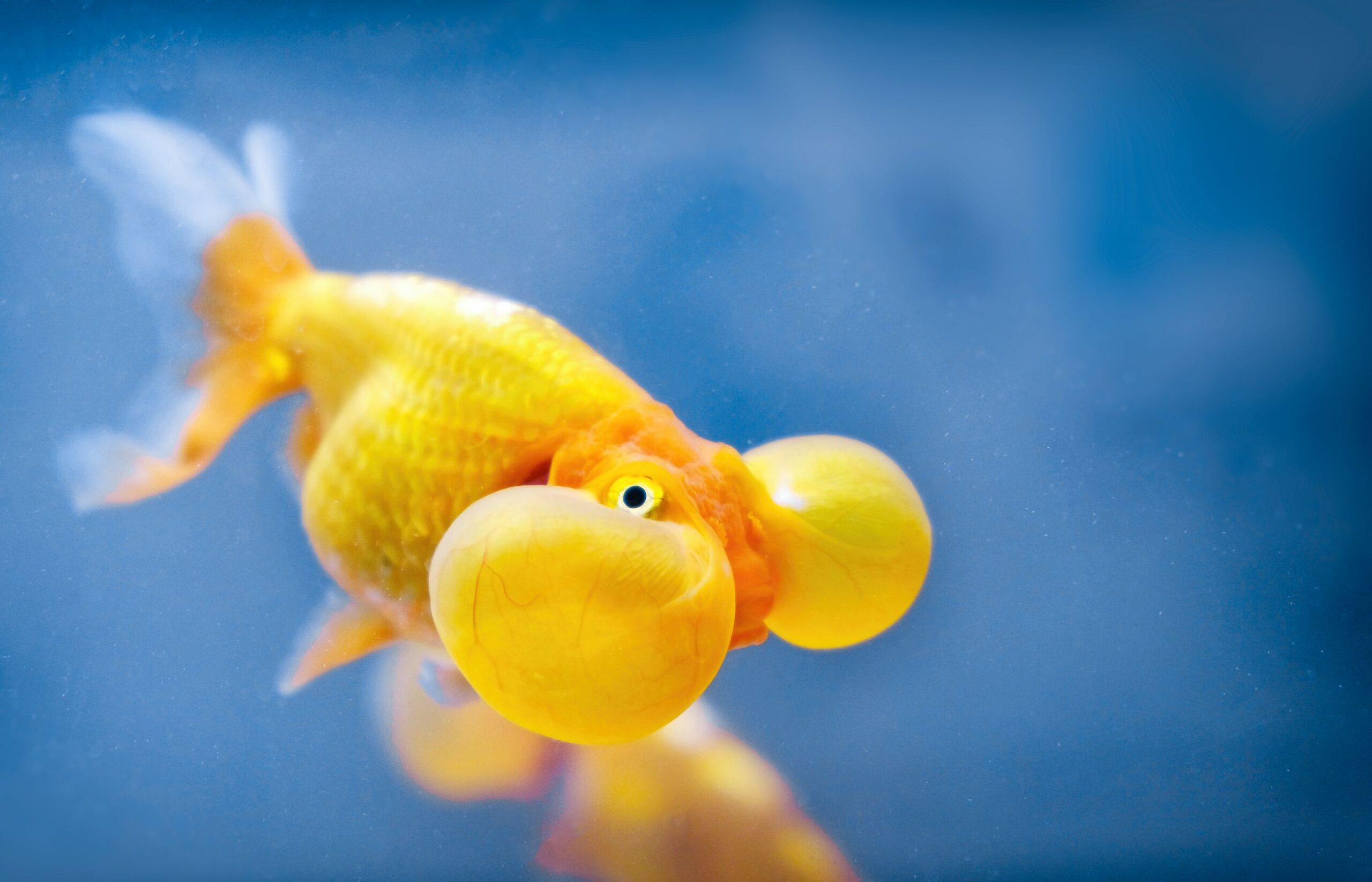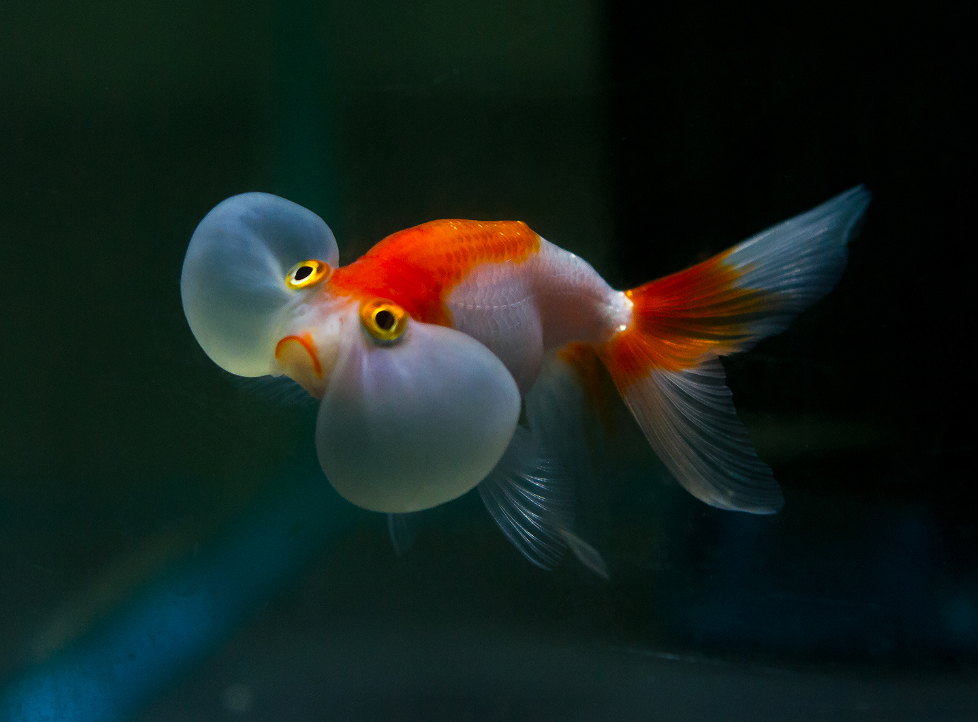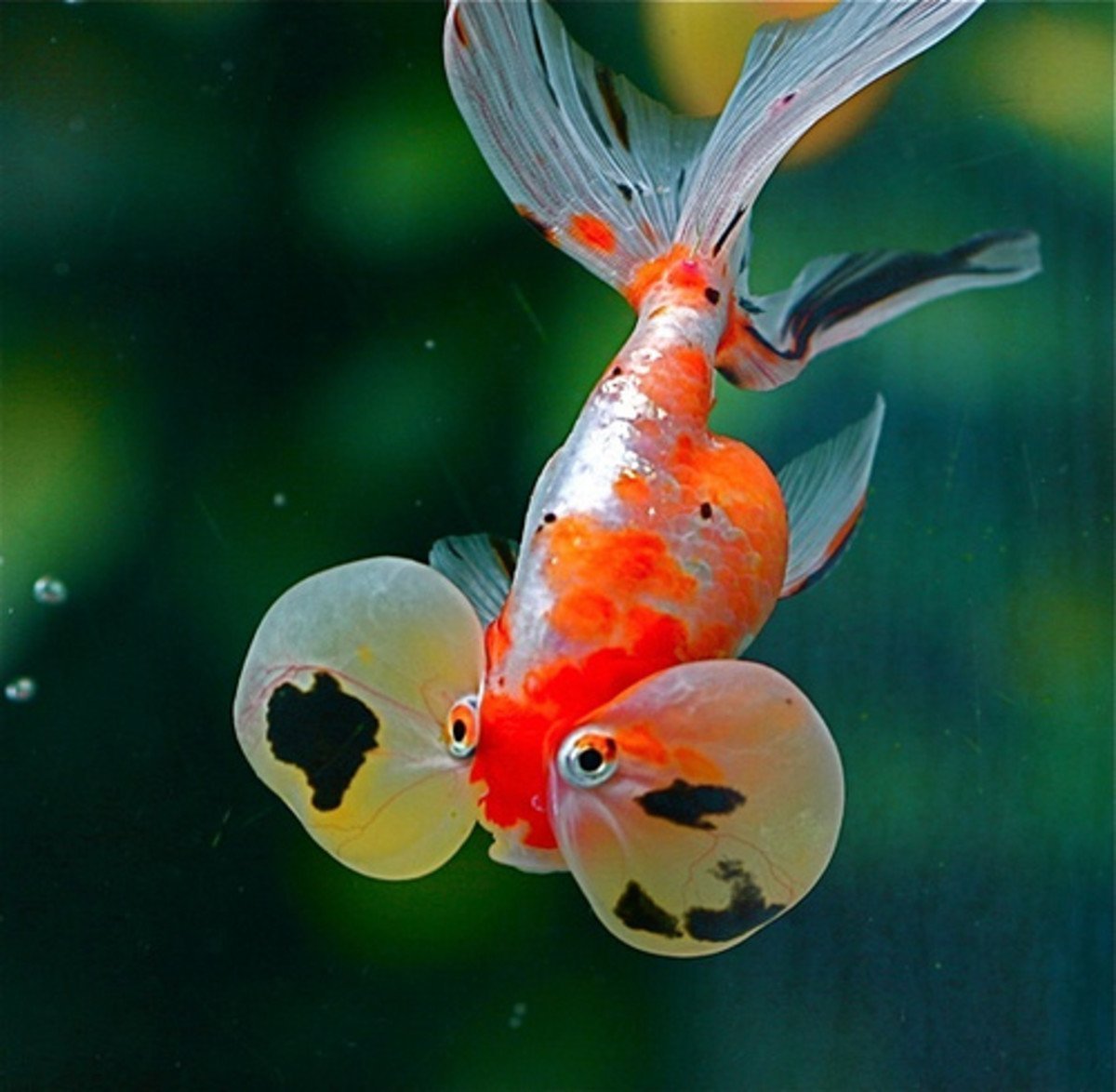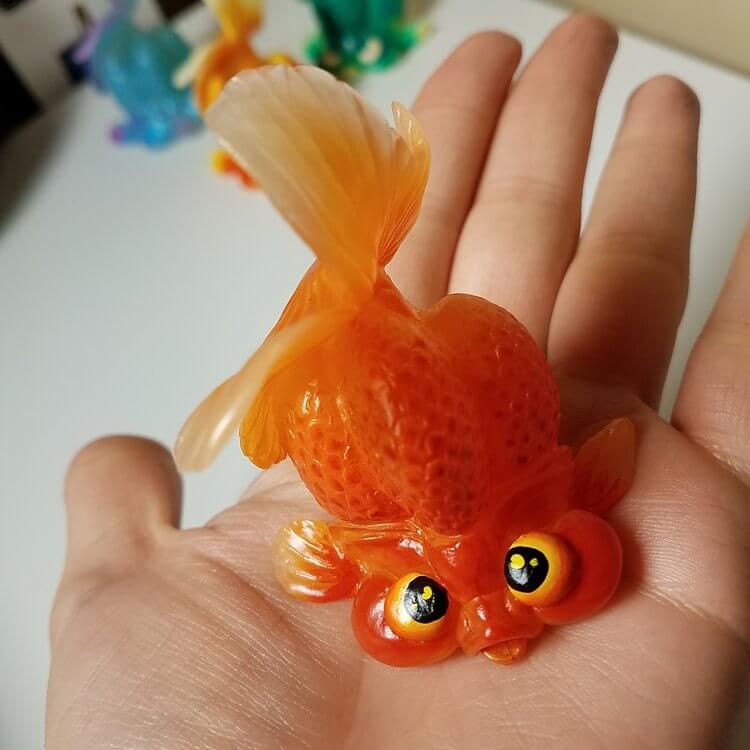
Descending from the original genetic line of the Comet goldfish, the bubbleeye goldfish has been manipulated over countless generations to have eye deformities as well as double tail fins. Selective breeding has created this favorite breed of goldfish and others, such as Ranchus, Orandas, and fantails. These fish are never found in the wild unless they are released by aquarists.

Like all other goldfish species, bubbleeye goldfish can range in color from orange to yellow to white. If they are bred with Shubunkin goldfish, they may have a floral pattern. They often have a stooped body and a drooping tail.
As their name suggests, these fish have a large ball of liquid under each eye. Located in a delicate flap of skin, these protrusions can interfere with the fish’s ability to swim and feed. You will see these bulges wrinkle and bend with the fish’s movements, which is normal for this type of goldfish.
When it comes to bubbleeye goldfish in the same tank, you should carefully consider the swimming and feeding abilities of other fish. Bubbleeye goldfish are very slow, clumsy swimmers and require patience when feeding. When you have two giant pillows under your eyes, eating can be a difficult process. If possible, bubbleeye goldfish should only be kept with other breeds of bubbleeye or telescopic goldfish, such as black moor goldfish. These blind fish all have equal opportunities to eat without much competition.
Even invertebrates, such as shrimp, can bite into your Bubbleeye Goldfish’s sensitive eye tissue, making them unsuitable tankmates. Snails are completely safe from predation by these fish but will often quickly overwhelm the tank due to their abundant breeding ability.
12 types of goldfish: From comet to fantail
When it comes to bubbleeye goldfish habitat and care, this breed requires more attention and consideration. With their large orbital structures, their habitat is relatively free of decorations, especially any type of abrasive leaves or other sharp decorations. Your Bubble Eye should be able to easily navigate all areas of their tank and not have any caves or crevices where they can get stuck.

With the possibility that your fish will at some point injure themselves, maintaining good water quality is paramount. Good water quality is key to providing your fish with a healthy response to any illness or injury. Remember to test your water chemistry regularly and follow regular maintenance procedures.
Although foraging in the bottom of the tank is normal behavior for goldfish, it can easily damage the delicate eye tissues of a bubbleeye goldfish. Do not use or use minimal substrate to avoid injury.
Another thing to consider when setting up an aquarium for your bladdereye is the water flow. With their short, often hunched bodies and obstructed eyes, these fish can easily be pushed around by the water flowing from your aquarium filter. You may need to limit filtration, which means your tank must have a lot of additional volume, or block your outflow with a sponge or other device to spread the filter layer back over a larger surface. Pay attention to how your bubbleeye goldfish swims around their tank and note any areas where they can’t linger for long without being pushed away.

If you notice a tear in one of your bubbleeye goldfish’s delicate eye skin folds, don’t try to repair it yourself. If the tear is less than 1 cm long then it will most likely heal on its own, as long as you maintain good water quality and your fish have a balanced diet. If the tear is longer, you may want to consult an aquatic veterinarian. These tears are difficult to suture due to the delicate eye tissue and the use of glue can cause a very painful inflammatory reaction in the fish. Your aquatic veterinarian will give you the best guidance to ensure your fish does not develop secondary infections due to potentially non-healing wounds.
When it comes to feeding bubble eyes, you have to be patient. Because this type of goldfish has difficulty with both vision and swimming ability, it takes them longer to eat than most other fish. This is why we recommend keeping them only with slower, better-looking goldfish or only with other species with bubble eyes.
When choosing a food, you may want to use a food that is slightly higher in protein (33-38%) than your goldfish’s regular maintenance diet. Fancy varieties have to expend more energy to swim normally, so a few extra calories can help them be more active.
Although not commonly recommended for fancy goldfish, bubbleeye goldfish should be fed a floating diet. Goldfish’s normal feeding behavior, rooting around the substrate, can cause eye problems. Feed the fish slowly and feed them one pellet at a time. If they can’t find their food, it’s more wasteful for you and your filter to clean up.
Like most goldfish species, bladdereye males may exhibit reproductive tubercles on the operculum or operculum and on the anterior edge of the pectoral fins. However, sometimes fancy goldfish do not exhibit these external characteristics. If your fish have difficulty swimming and feeding, they may not be interested in developing strong reproductive structures, which is normal for most goldfish breeds.
If you are interested in breeding bubbleeye goldfish, please carefully consider the welfare of these fish. You may want to consider having your veterinarian perform a complete examination, including an ultrasound to confirm gender, to ensure the fish you want to keep is in good health.
Like keeping other goldfish species, bubbleeyes like to have plant roots where they can lay their eggs. Remember to choose soft plants, preferably live plants, such as Anacharis , to ensure your fish are not injured in their breeding bliss. After the eggs are laid and fertilized, move the mother and father to another tank so they don’t eat the eggs or their babies. After a few days, the fry will hatch and need a diet rich in protein and fat to develop normally. There are commercial fry foods available or you can grow infusoria plants to raise the fry.
Breeding goldfish can produce many different characteristics. Don’t assume that two bubble-eye goldfish will only produce bubble eyes. You will often get other characteristics from the fish’s lineage.
If you are interested in Bubble Eye Goldfish, you may want to check out these other goldfish breeds:
Check out additional fish breed profiles for more information on other freshwater fish species.





